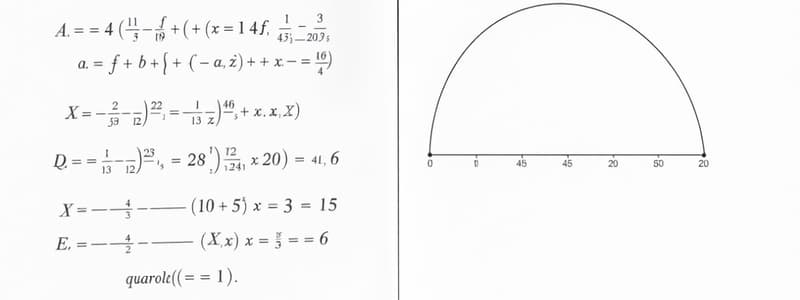Podcast
Questions and Answers
What method can be used to find the roots of a quadratic equation?
What method can be used to find the roots of a quadratic equation?
- Using the quadratic formula (correct)
- Factoring only
- Graphing only
- Substituting values directly
When graphing a quadratic equation, what is the shape of the graph called?
When graphing a quadratic equation, what is the shape of the graph called?
- Circle
- Parabola (correct)
- Hyperbola
- Line
Which of the following correctly describes the relationship between the coefficients and the number of real roots in a quadratic equation?
Which of the following correctly describes the relationship between the coefficients and the number of real roots in a quadratic equation?
- The number of real roots is always equal to the number of coefficients.
- The quadratic may have no real roots if the discriminant is negative. (correct)
- The number of real roots is unaffected by the value of the discriminant.
- The quadratic will always have two real roots irrespective of its coefficients.
Which step is essential when solving a quadratic equation by factoring?
Which step is essential when solving a quadratic equation by factoring?
What does a parabola that opens upward indicate about the solutions of the quadratic equation?
What does a parabola that opens upward indicate about the solutions of the quadratic equation?
Flashcards are hidden until you start studying
Study Notes
Finding Roots of Quadratic Equations
- The quadratic formula, given by (x = \frac{-b \pm \sqrt{b^2 - 4ac}}{2a}), can be used to find the roots of a quadratic equation (ax^2 + bx + c = 0).
Shape of the Graph
- The graph of a quadratic equation is shaped like a parabola, which can open either upwards or downwards depending on the leading coefficient (a).
Coefficients and Real Roots
- The relationship between the coefficients (a), (b), and (c) and the number of real roots is determined by the discriminant (D = b^2 - 4ac):
- If (D > 0): two distinct real roots.
- If (D = 0): one real root (a repeated root).
- If (D < 0): no real roots (complex roots).
Essential Step in Factoring
- An essential step when solving a quadratic equation by factoring is to first express the quadratic in standard form and then find two numbers that multiply to (ac) (the product of coefficients (a) and (c)) and add to (b) (the linear coefficient).
Parabola Opening Upward
- A parabola that opens upward (when (a > 0)) indicates that the quadratic equation has either two real roots if the vertex is above the x-axis, or one real root if the vertex touches the x-axis.
Studying That Suits You
Use AI to generate personalized quizzes and flashcards to suit your learning preferences.




